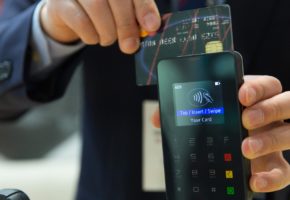As you’ve probably heard, credit card processing machines are beginning to switch from traditional magnetic-strip swiping to microchip reading when processing credit card transactions. This means that the financial information supplied by payment cards will be stored primarily in microchips embedded in cards. Instead of swiping the magnetic strip on the back of cards to process your transactions, you’ll be inserting the microchip into a reader on your processing machine. In this post, we’ll cover a few of the reasons why this switch is being made.
Safety and Security
The first and most important reason for the switch is security. Chip-enabled cards provide better security measures against fraud and data theft. Traditional magnetic strip cards use a magnetic field to transmit data. This technology makes it easier for thieves to capture and clone your information onto a new card. Chip technology, on the other hand, is constantly changing, making it more difficult to extract information.
When you use magnetic strip technology to swipe a card with your credit card processing machines the information is sent to the bank as it is. In other words, the data isn’t encrypted until it’s been input into your card reader. Chip technology utilizes sophisticated encryption built right into the chip. That way, sensitive financial information is always encrypted, making it more difficult to steal.
Catching Up
Another prominent reason for the switch to chip cards in the US is that most of the world already operates on this system. Other markets have had success protecting consumer information by switching to chip and PIN systems and the American market is finally catching up. This will bring uniformity to a global credit card market that is more and more connected every day. Furthermore, it will deter global credit card theft, as many of the large breaches of American card information originate overseas.
New Technology
Another major reason for the switch is to replace aging credit card processing machines. Many businesses use old machines that aren’t able to read chips. New machines will be able to read chips, swipe magnetic strip cards, and process NFC (near field communication) transactions. Every day, more and more consumers are using their mobile devices as a form of payment. Products like Apple Pay and Google Wallet use wireless communication to process payments, and merchants need machines that can keep up with this technology.
Liability Shift
Finally, as part of the switch, there is the issue of liability. In essence, when fraud happens, liability determines who is responsible for any associated costs. In the future, whichever party has the lesser technology will bear the liability for fraud. For example, if your business doesn’t offer a chip reader, you’ll be liable for the costs. Likewise, if a card doesn’t include the chip but you offer chip reading credit card processing machines, the issuing bank will be liable.
Choose Allied Wallet
Making the switch from traditional magnetic strip cards to the chip will increase security, bring financial communications systems up to date, and prepare us for coming changes in payment technology. If you want to learn more or have questions about the shift, contact Allied Wallet today for information from the leading credit card processor.






